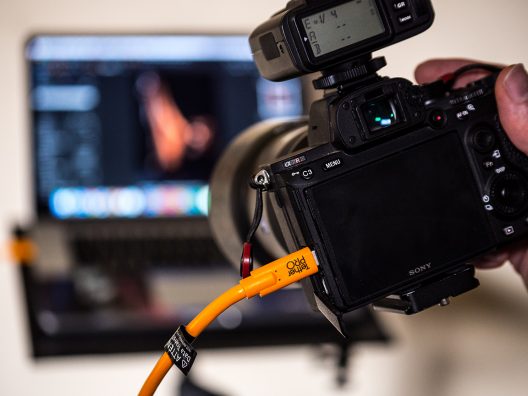
In my lifetime I have gone from learning how to shoot on 35mm film and develop in a darkroom, to working with models that don’t even know what film is–yes, that really has happened–and I’m only in my thirties. Photography changes at the speed of light—pun definitely intended. The fun challenge is to learn how to adapt and work with the ever-advancing wall of technological advances while maintaining the art and integrity of the craft we cherish. The business has become so much more about managing client expectations and the need for immediate gratification, than it is trusting the hired professionals to get the shot. Style and skill still matter, but take a backseat when the budget is on the line. With the advent of the digital camera and its ability to preview each shot taken, clients now have come to expect to participate in the process. That has become the need that we need to manage and simplify every day in order to compete and create successful shoots.
Almost as if by magic came the ability to tether. My first pro-level camera lacked this innovation, and I moved forward in blissful ignorance of the capability to ease the stress of my client counterpart. As I watched and grew as a professional, I noticed that not only was the technology and capability to tether great for the client, but it was great for me. It was something that I was almost foolish for not adapting to earlier. It’s an image-making failsafe and a beautiful piece of technology that cuts out the claustrophobic guesswork.
The inevitable next step in that evolution is cutting the cables with wireless tethering. Enter the Tether Tools’ Air Direct. I’ve been tethering with a cable for years, but I knew I had to try out the Air Direct. Let me show you why.
My Studio Setup
This is my studio. It’s small, but I love it. My favorite reaction is when clients look at my images, see the space I shot them in and are flabbergasted. It makes me smile that something so seemingly insignificant to me can surprise them. When the space is wide open it seems fairly roomy, but that room disappears the moment I set up my gear. So much for something spacious; welcome to entropy.
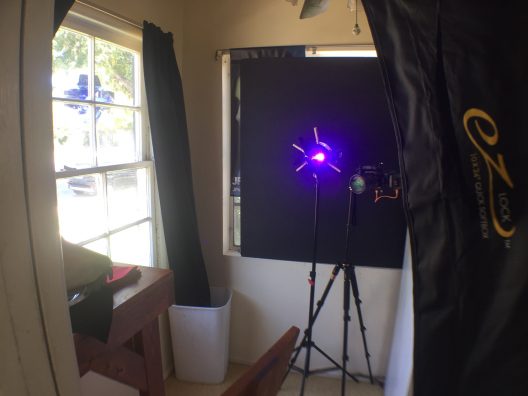
In the swirling maelstrom of light stands and modifiers, I somehow have to place models and products and produce a result. And! While achieving that result, I have to share the progress with the models, the clients, and maybe even more importantly, myself. The overwhelming presence of equipment can sometimes make it hard to see the details in the shot, especially on glossy product shots. Tethering lets me see them on the big screen and zoom in on the details, avoiding hours of retouching and potential hazards. It lets me share shots with the models, getting them excited to see the results and how they can improve their poses.
Hidden in the shadows of that challenge is an even bigger hazard. There’s a fifteen-foot cable snaking its way from our most sensitive and expensive piece of equipment to our second most sensitive and expensive piece of equipment. It always feels like my camera and computer are on the verge of being torn from their perches and tossed asunder. Tether Tools is the industry’s leading experts on tethering and have created some great tools for keeping the cables from jerking out of the computer and the camera, but there is no protection from the perfect storm of my clumsiness felling both things at once.
The Air Direct, however, solves this problem perfectly. There are no cables over which I can trip. It’s a revelation to know I’m cable free, and it makes me happy. This article is not a sales pitch for the Air Direct though. Tether Tools has a marketing department for that. All I want to offer is my experience. After all, I can’t tell you what to buy. That decision is up to you.
One of my least favorite questions from new and amateur photographers is, “What’s the best camera?” It’s an impossible question. There’s no right answer. There is a litany of questions that needs to be answered first. What do you want to do? What do you plan on shooting? How do you work? What is your workflow and skillset like? How much do you want to spend? Investing in and choosing the right tethering equipment is no different.
There are distinct advantages and disadvantages to each method of tethering. None of them are a reason not to tether, but understanding the challenges and benefits, added to how you work, matters. The goal is to create an efficient and easy workflow that benefits you as the photographer from exerting more effort than you need to on the technical end. That way you can stay in the creative moments and get the shot.
So cut to the chase, what are the good and the bad? Well, let’s get into it. We’ve already touched on it a bit.
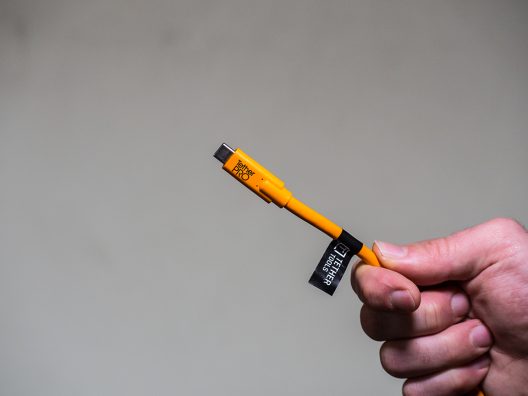
Advantages to Wired Tethering:
- Lightning fast transfer speeds, up to 10gbps
- Instant previews
- Live monitor
- Slim profile – no bulky extras
Disadvantages to Wired Tethering:
- Tripping hazard
- Distance limitation
The Air Direct solves more than just the possible equipment faceplant. One of the biggest benefits is being able to truly be remote. During my “Fancy Fox” shoot, I was setting a light outside of a window to project the window frame lines on the scene. Since there was no assistant for such a silly experiment, it was left to me to run back and forth, tweaking the height, angle, and depth of the light and stand. Fortunately, with the Air Direct hooked up, all I had to do was take my laptop outside with me, and tweak to my heart’s content—firing off remote test shots from my Capture One remote trigger. It saved time, energy, and quite a bit of sanity (I mean, I dressed up in a suit and wore a Fox mask. Who are we kidding? I already lost my sanity). However, just as with wired, wireless has some distinct challenges of its own.
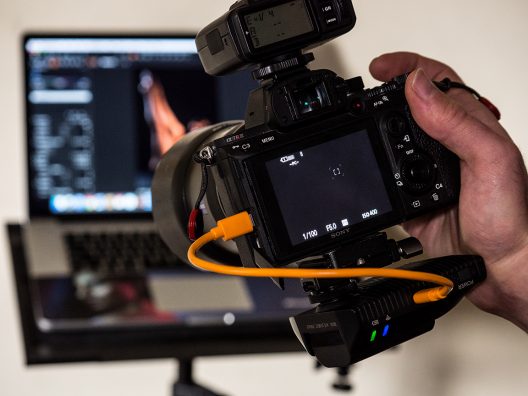
Air Direct Advantages:
- No long cables (yay!)
- 150-foot distance
- Mobility and modularity
- Compact footprint for the photographer
Air Direct Disadvantages
- Slightly slower transfers of RAW files (We can discuss this later)
- Extra equipment on the camera
- Need for additional peripherals
Now here’s the thing. There are people that will balk at both sides of both of these lists. The reality is that these are just an emotionless list of facts. We all have reasons for going in either direction. Here’s what I found for me: The way I currently work calls for lightning-fast transfer speeds. It’s essential to how I personally work. I abhor being tied to a cable, but it’s a small price to pay for my personal workflow.
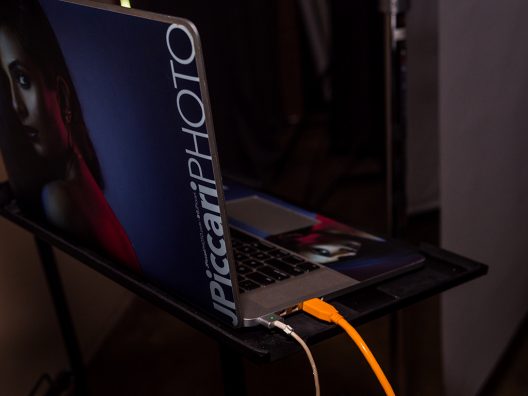
These days it’s impossible to run away from adapting to the new technologies that are aimed at making our professional lives easier and the tools that improve every aspect of our career. There’s no reason to fight them. Investing in the right gear is what pushes us to be better, builds and maintains our businesses, and separates the serious photographers from the ones that are just messing around. Tethering is something that every pro should have, at least, the ability to do. Fortunately, there are multiple options to help be an asset to your workflow. Whether you prefer wired or wireless functionality is up to your preferences. While historically I err on the side of “If it ain’t broke, don’t fix it”, you better bet that next time I’m ready for an upgrade…the Air Direct is on my short-list. I can’t wait to be wired less.
About Justin Piccari
Justin Piccari is a Los Angeles-based photographer specializing in high-contrast, low-light, and cinematographic imagery called “Reality: Enhanced.” Visit his site here.



